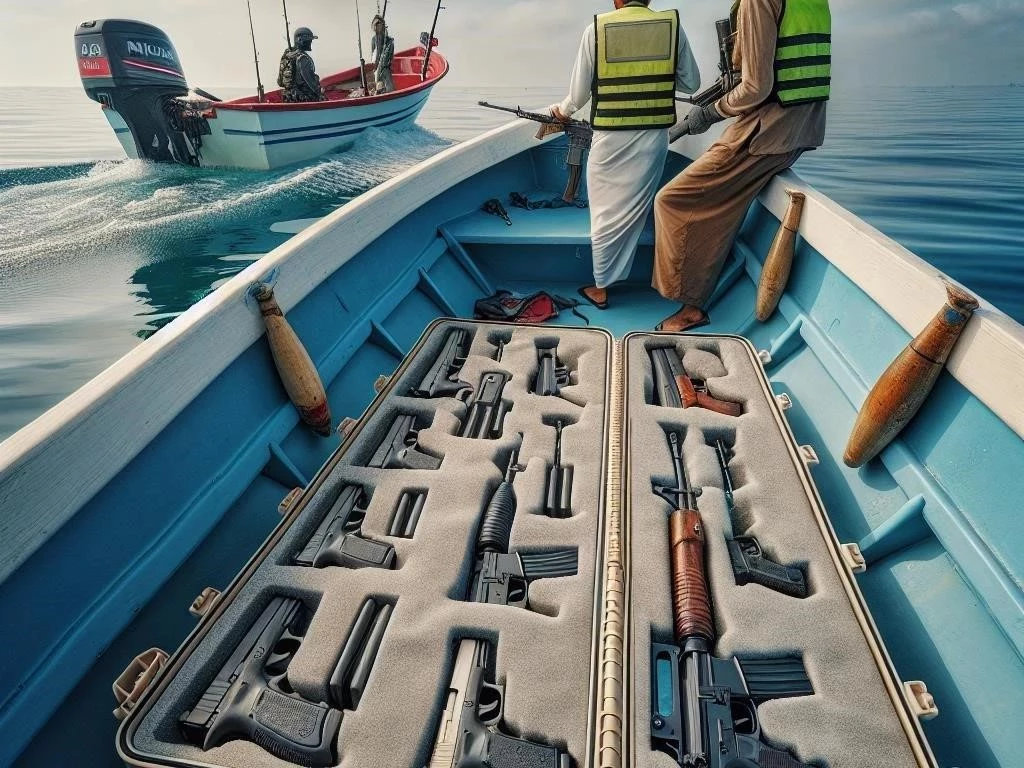How Should Firearms Be Transported in a Boat
Understanding the importance of firearm safety during boat transport is essential. This article outlines crucial guidelines, legal requirements, and best practices for secure handling in the marine environment.
Understanding Firearm Safety
Firearm safety is paramount when transporting weapons on boats. Adhering to boating laws, storage regulations, and secure handling practices ensures compliance and minimizes risks in the marine environment.
Importance of Firearm Safety
Firearm safety is crucial when transporting weapons on a boat, as improper handling can lead to accidents, injuries, or even fatalities. Understanding the legal requirements ensures compliance with local laws and regulations. Safe storage and secure handling practices are essential to prevent unauthorized access and accidental discharge. Furthermore, in the marine environment, factors such as waves and instability can increase risks associated with firearms. By implementing safety precautions, individuals can significantly reduce the likelihood of firearm-related incidents. Taking boating safety courses not only enhances knowledge about boating laws but also provides valuable insights into risk management strategies when firearms are involved. Proper firearm maintenance is also vital, ensuring that weapons function correctly and safely. Ultimately, prioritizing firearm safety during watercraft transport protects not only the individual but also others on board and in the surrounding area, fostering a responsible and safe boating experience.
General Firearm Safety Guidelines
When transporting firearms on a boat, adhering to general firearm safety guidelines is essential for preventing accidents. First, always treat every firearm as if it is loaded, maintaining a cautious mindset. Ensure firearms are unloaded before transport and stored in secure gun cases to prevent unauthorized access. Use appropriate ammunition transport methods, keeping ammunition separate from firearms, and in a locked container if possible. Familiarize yourself with local boating laws and firearm storage regulations, as they can vary significantly between jurisdictions. Secure handling practices must be observed, including keeping firearms pointed in a safe direction at all times. Implement load distribution strategies to maintain balance and stability of the watercraft, minimizing the risk of capsizing or accidents. Regularly inspect firearms for maintenance issues, and establish emergency procedures to handle any firearm-related incidents that may arise during your boating journey.
Legal Requirements for Firearm Transport
Understanding legal requirements for firearm transport is essential. Different states have unique boating laws, storage regulations, and guidelines that dictate how firearms must be securely handled and stored.
Boating Laws and Firearms
When transporting firearms on a boat, understanding boating laws related to firearms is essential for compliance and safety. Each state has specific regulations governing the transport and use of firearms on watercraft. Some states require firearms to be unloaded during transport, while others may mandate that firearms be stored in secure gun cases. Familiarizing yourself with these laws helps mitigate the risk of legal issues. Additionally, certain states may also have restrictions on the types of firearms allowed on boats, particularly in designated waterways. It is crucial to check local boating laws and regulations before embarking on any fishing trips or hunting excursions. Keep in mind that ignorance of the law is not an excuse, so ensure you are well-informed. By adhering to boating laws regarding firearms, you not only protect yourself legally but also promote a safe and responsible boating environment for everyone involved.
Storage Regulations in Different States
Storage regulations for firearms during boating vary significantly from state to state. Understanding these differences is crucial for safe and legal transport. Some states mandate that firearms be completely unloaded and stored in locked containers while on a boat. Others may allow firearms to be kept in accessible locations, provided they are secured in gun cases. It is also important to consider the specific requirements for ammunition transport, as some jurisdictions require ammunition to be stored separately from firearms. Certain areas may have additional restrictions in designated wildlife conservation zones or near populated regions. Familiarizing yourself with local laws and regulations before embarking on any boating adventure is essential. This knowledge not only protects you from potential legal repercussions but also contributes to overall safety on the water. Always consult state resources or local law enforcement for the latest storage requirements, ensuring compliance and responsible firearm handling.
Secure Handling of Firearms on Boats
Secure handling of firearms on boats is critical. Following best practices, using appropriate gun cases, and ensuring compliance with boating laws will enhance safety and reduce potential risks during transport.
Best Practices for Secure Handling
When transporting firearms on a boat, adhering to best practices for secure handling is essential to ensure safety. First, always ensure that firearms are unloaded before boarding the vessel. Store firearms in locked gun cases, preventing unauthorized access and accidental discharge. When handling firearms onboard, maintain a safe direction, pointing the muzzle away from people and vital areas. Establish a designated area on the boat for firearms, keeping them secure and out of reach from children or untrained individuals. Additionally, use safety straps or nets to prevent firearms from shifting during travel, which could lead to accidents. Regularly check the condition of firearms to ensure they are functioning correctly and safely. Lastly, familiarize all passengers with firearm safety protocols before setting out on the water; Implementing these best practices not only promotes a safer environment but also fosters responsible firearm ownership during boating excursions.
Choosing the Right Gun Cases
Selecting the appropriate gun cases for transporting firearms on a boat is critical for ensuring safety and compliance with regulations. When choosing a gun case, opt for one that is durable, waterproof, and lockable, as these features provide protection from the marine environment and unauthorized access. Hard cases are often recommended for maximum protection, as they can withstand impact and offer better security than soft cases. Ensure that the case is spacious enough to accommodate your specific firearm, including any accessories. Additionally, consider cases with padding to prevent damage during transport. Verify that the gun case meets any legal requirements for storage and transport in your state. It’s also wise to label the case discreetly to avoid drawing attention. By carefully selecting the right gun case, you can enhance safety, maintain firearm integrity, and comply with legal obligations during your boating adventures.
Ammunition Transport Guidelines
Following proper ammunition transport guidelines is essential when boating. Ensure ammunition is stored securely, kept separate from firearms, and complies with local laws to enhance overall safety and responsibility.
Safe Storage of Ammunition
Ensuring safe storage of ammunition when transporting firearms on a boat is vital for preventing accidents and maintaining compliance with legal requirements. Store ammunition in a dedicated, secure, and waterproof container to protect it from water exposure and environmental elements. It is important to keep ammunition separate from firearms to minimize risks, particularly in the event of an accidental discharge. Use containers specifically designed for ammunition, which often feature compartments to prevent movement and damage. Additionally, label the container discreetly to avoid drawing unnecessary attention while remaining compliant with local laws. Always store ammunition in a location that is not easily accessible to unauthorized individuals, especially children. Regularly check the condition of the ammunition to ensure it is in good working order. By adhering to these safe storage practices, you can significantly reduce the risks associated with transporting ammunition during boating activities and enhance overall safety.
Legal Requirements for Ammunition Transport
Understanding the legal requirements for ammunition transport while boating is crucial for compliance and safety. Regulations vary significantly between states, so it is essential to familiarize yourself with local laws regarding the transport of ammunition. Many jurisdictions mandate that ammunition be stored separately from firearms, often requiring it to be in a locked container to prevent unauthorized access. Additionally, some states impose restrictions on the amount of ammunition that can be transported at one time, especially in designated areas. It is also important to check whether there are specific regulations related to the type of ammunition being transported, as certain types may be prohibited in particular regions. Always ensure that your transport methods comply with both federal and state laws to avoid legal repercussions. By adhering to these legal requirements, you not only protect yourself but also promote a safer environment for everyone involved during boating activities.
Boating Safety Courses and Firearm Transport
Participating in boating safety courses enhances knowledge about firearm transport laws, safety precautions, and best practices, ensuring a secure and responsible boating experience while handling firearms on watercraft.
Importance of Boating Safety Courses
Boating safety courses play a crucial role in educating individuals about the safe transport of firearms while on the water. These courses cover essential topics such as boating laws, storage regulations, and secure handling practices specific to firearm transport. By participating in these courses, boaters gain a deeper understanding of the risks associated with firearms in a marine environment, as well as the legal requirements that must be adhered to. The knowledge gained helps individuals make informed decisions regarding firearm safety, enhancing overall responsibility during boating activities. Furthermore, these courses often emphasize the importance of risk management strategies and emergency procedures, equipping participants with the skills needed to handle unexpected situations involving firearms. Ultimately, enrolling in a boating safety course fosters a culture of safety and respect for both firearms and fellow boaters, contributing to a safer recreational experience on the water.
Topics Covered in Boating Safety Courses
Boating safety courses encompass a variety of essential topics related to the safe transport of firearms on watercraft. Participants learn about local boating laws and regulations pertaining to firearms, ensuring awareness of legal requirements. Courses typically cover secure handling practices, emphasizing the importance of safe storage methods for firearms and ammunition during transport. Risk management strategies are also discussed, including load distribution techniques to maintain stability on the boat. Additionally, emergency procedures for firearm-related incidents are highlighted, equipping participants with the knowledge to handle unexpected situations effectively. Other topics may include proper maintenance of firearms in the marine environment, ensuring they remain in good working order. By addressing these subjects, boating safety courses prepare individuals for responsible firearm transport, fostering a culture of safety and compliance on the water. This comprehensive understanding helps promote a safer experience for all boaters and encourages respect for firearm regulations.
Risk Management While Boating with Firearms
Implementing effective risk management strategies while boating with firearms is essential. Proper load distribution, emergency procedures, and awareness of potential hazards can significantly enhance safety during transport and recreational activities.
Load Distribution and Stability
Proper load distribution and stability are crucial factors when transporting firearms on a boat, as they directly impact the safety of all onboard. Ensuring an even distribution of weight helps maintain the boat’s balance and prevents capsizing. Start by placing heavier items, including firearms and ammunition, in the center of the boat, close to the floor for better stability. This lowers the center of gravity, enhancing overall balance. Avoid placing heavy items towards the bow or stern, as this can create instability and affect steering. Additionally, secure all firearms and gear to prevent movement during transit, which could lead to accidents or injuries. Regularly assess the boat’s stability while loading, making adjustments as necessary. By prioritizing load distribution and stability, you can minimize risks and create a safer environment for everyone onboard, ensuring a more enjoyable experience during your boating activities.
Emergency Procedures for Firearm-Related Incidents
Establishing clear emergency procedures for firearm-related incidents while boating is essential for ensuring safety and preparedness. First, all passengers should be informed of the location of firearms and the importance of not handling them without proper training. In the event of an accidental discharge or injury, immediately assess the situation and prioritize safety, ensuring that everyone is out of harm’s way. If someone is injured, administer first aid if qualified and call for medical assistance without delay. Secure the firearm involved in the incident to prevent further accidents, placing it in a safe location away from individuals. Additionally, report the incident to local authorities, as required by law, to ensure compliance with regulations. Conduct regular drills to practice these emergency procedures, reinforcing their importance among all passengers. By being prepared and knowing how to respond, you can significantly reduce risks and maintain a safe environment during boating activities.
Firearm Maintenance During Boating Trips
Proper firearm maintenance during boating trips is essential. Regular inspections, cleaning, and appropriate storage techniques will ensure reliability and safety while transporting firearms in marine environments.
Routine Checks and Maintenance
Conducting routine checks and maintenance on firearms during boating trips is essential for ensuring their reliability and safety. Before embarking on any journey, inspect each firearm for signs of wear, rust, or damage. Check that all components are functioning correctly, including triggers, safeties, and magazines. Clean firearms thoroughly after each use, especially after exposure to saltwater or humidity, to prevent corrosion and maintain optimal performance; Use appropriate cleaning supplies and follow the manufacturer’s guidelines for maintenance. Store firearms in a secure, dry location, utilizing waterproof cases to protect against moisture. Regularly check the condition of ammunition as well, ensuring it remains in good working order. Additionally, develop a routine schedule for comprehensive inspections, allowing you to catch potential issues before they become significant problems. By prioritizing routine checks and maintenance, you can enhance safety and ensure that firearms perform reliably throughout your boating experiences.
Storing Firearms in a Marine Environment
Storing firearms in a marine environment requires careful attention to prevent damage from moisture, salt, and other environmental factors. First, always use waterproof gun cases designed specifically for marine conditions, as these provide essential protection against water exposure. Ensure that firearms are thoroughly cleaned and dried before storage to prevent rust and corrosion. Utilize desiccants inside the storage case to absorb moisture and maintain a dry environment. When stowing firearms on a boat, position them in a secure and stable area to prevent movement and potential damage during transit. Consider using padded dividers or compartments to avoid contact between firearms and other equipment. Additionally, ensure that firearms are locked and stored out of reach from unauthorized individuals, particularly children. Conduct routine inspections of both firearms and storage conditions to identify any issues early. By following these guidelines, you can effectively protect firearms while enjoying activities in a marine setting.
Best Practices for Fishing Trips with Firearms
Implementing best practices for fishing trips with firearms ensures safety and compliance. Proper storage, secure handling, and adherence to legal regulations are vital for a successful fishing experience.
Integrating Firearms into Fishing Activities
Integrating firearms into fishing activities requires careful planning and adherence to safety protocols to ensure a seamless experience. Before heading out, familiarize yourself with local regulations regarding the use of firearms while fishing, including any restrictions on specific areas. When transporting firearms, ensure they are securely stored in waterproof cases to prevent damage from water exposure. Maintain a clear distinction between fishing gear and firearms, keeping them organized to avoid confusion. Always prioritize safety by keeping firearms pointed in a safe direction and ensuring they are unloaded until necessary. If you plan to use the firearm for hunting during your fishing trip, communicate openly with fellow anglers about your intentions, and establish clear safety guidelines. Additionally, consider the impact of noise on fish behavior and avoid unnecessary disturbances. By integrating firearms responsibly into fishing activities, you can enhance your experience while promoting safety and compliance on the water.
Safety Precautions for Fishing Trips
Implementing safety precautions during fishing trips with firearms is crucial for ensuring the well-being of everyone involved. First, always ensure that firearms are securely stored and unloaded while on the watercraft, except when in use. Utilize locked, waterproof cases for storage, preventing unauthorized access and protecting against environmental damage. Establish clear communication with all participants regarding firearm safety rules and their specific roles during the trip. Ensure that everyone on board understands the importance of maintaining a safe distance from firearms at all times. During fishing activities, keep firearms pointed in a safe direction, and never handle them while the boat is in motion. Be aware of your surroundings, including other boats and anglers, to prevent accidents. Finally, conduct a safety briefing before setting out, covering emergency procedures for firearm-related incidents. By prioritizing safety precautions, you can create a secure and enjoyable fishing experience for all participants.














Post Comment